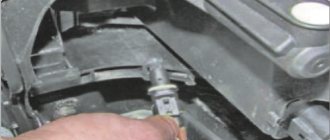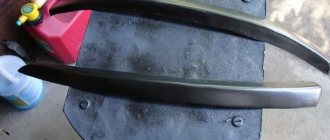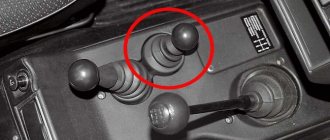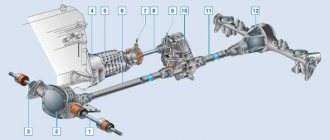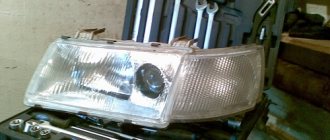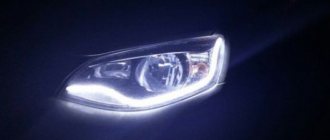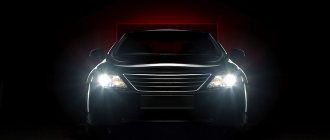Car headlights are a kind of vehicle indicator for other road users, a device for illuminating the road and increasing visibility in conditions of poor visibility.
Many drivers, especially beginners, do not remember about car headlights as long as they are in good working order and reliably illuminate their way.
But as soon as breakdowns occur, which, as a rule, lead to the inability to drive at night (and, according to the new rules, during the day), and also, in many cases, lead to the purchase of new lamps or headlight glasses, the importance of these lighting devices becomes obvious.
But today we will not talk about the design and repair of car lighting devices, but about the rules for their use and the history of their creation. We think that on this topic we will open the eyes of many drivers.
Rules for using car headlights
The low beam headlights together with the side lights must be turned on when the car is moving, even on a lit city road. For Ukraine, this rule is valid from October 1 to May 1 and only when driving outside the city.
In case of insufficient visibility or in the dark, when driving in tunnels, the driver has the choice of turning on high or low beam headlights.
When driving 150 meters before oncoming traffic, switch the high beam to low beam. You will also need to switch if an oncoming driver signals possible blinding.
These are the basic requirements of the Road Traffic Regulations for the use of external lighting devices. To learn more about the procedure for using headlights, you can look at the traffic rules.
How does a modern headlight work?
No matter what car headlights we come across, their design features allow us to determine three main elements that ensure the operation of the optics.
Light source
The source of luminous flux for any headlight is the main element. The most common sources in modern cars are halogen lamps. A couple of decades ago, xenon lamps appeared and competed with halogen lamps. Finally, relatively recently, cars began to be equipped with LEDs.
Light reflector
The second most important component of the headlamp is the light reflector. It is a plastic or glass product with a small aluminum coating. The main task of this element comes from its name - it is designed to reflect the flow of light coming from the source and increase its power. Correctors and light screens, as auxiliary elements, distribute light rays in the correct direction.
Reflectors come in different types and are mainly divided into three types:
- Parabolic: the simplest and most affordable type, its design is static. Headlights with a parabolic reflector cannot be adjusted by changing the brightness, intensity and direction of the light flow.
- The free-form reflector is divided into zones that reflect individual light streams. The light in such a design is static, but when it is scattered, its light loss is an order of magnitude less than that of a parabolic reflector. In addition, in this case, the headlights are more comfortable for drivers of oncoming vehicles.
- Ellipsoidal reflector. Of the presented types, this is the most expensive, but also the most effective: it eliminates light loss and dazzling other road users. The work is structured as follows: the luminous flux is amplified by an elliptical light reflector and directed to another focus in the form of a partition, which again collects the light. Here the light is again scattered towards the lens, which, in turn, truncates or redirects it. In addition to the price, the downside is that with prolonged use, efficiency decreases and malfunctions appear. In this case, there is a direct route to a car service center and extra costs for repairs. It is impossible to make lens adjustments and repairs on your own without special equipment.
Diffuser
The lens is the outer part of the headlight, clear glass or plastic. On its inner part there are lenses and prisms of different sizes from 1 mm to several cm. The main task of the diffuser is to protect the light source from external influences, disperse the flow of light and direct it to the right place. The direction of the light flux is regulated by different shapes of the diffusers.
History of headlight development
The history of headlight development dates back to 1779, when Ivan Kulibin developed a parabolic reflector, which is still actively used today in car lighting equipment.
Directly as a method of illuminating vehicles, headlights appeared in 1896. They worked on acetylene. An acetylene generator was installed on the car. At its bottom was calcium carbide. When the lever was turned, water flowed to the carbide, forming the necessary acetylene. The gas flowed through rubber tubes into a burner installed in a focal reflector.
And here it was necessary to open the headlight glass flap, bring a burning match and the headlights started working for a whole four hours. After this time, everything had to be repeated all over again.
The degree of road illumination with acetylene headlights was characterized by high levels. They fully provided the visibility of three hundred meters required in accordance with safety standards.
A high rate was ensured by parabolic reflectors and lenses.
How to control the headlights
Different brands of cars provide their own control for turning the headlights on and off. Budget car options are equipped with simple manual controls in the form of a special switch. It can be found under the steering wheel or on the control panel itself.
New cars are equipped with an automatic device that allows you to turn on the headlights in certain circumstances: when you start the car's engine or even when opening and closing the doors. The device can be combined with a rain sensor or other devices that respond to external lighting.
Front headlights are improving every year, new shapes, designs, and internal fillings are appearing. Everything is aimed at ease of driving and a high level of safety. In any case, the main task of headlights will always remain the same - to protect the driver and passengers from unforeseen situations when driving in conditions of limited visibility and lighting.
Projector, bifocal headlights
The latest generation of headlights are bifocal projector ones. They will provide the driver with the best visibility and safety while driving. As a rule, they are installed on heavy vehicles and expensive foreign cars.
The second focus collects the rays in a reflector and directs them through the screen, re-focusing with the lens. Light performance of projector headlights - 50%
.
These headlights are significantly more expensive than the two previous types.
Halogen
This type of automotive optics is considered the most popular due to the simplicity of the operating principles and the wide range of prices per set. That is, you can choose them to suit any budget, which is what car owners really like. For this reason, they are often equipped with cars directly on the assembly line, although in terms of color temperature and brightness, halogens are inferior to more modern LED and xenon headlights.
The name of the headlights comes from the light source, which is a lamp filled with halogens of various gases. That is, in essence, it is just an improved version of the incandescent lamp used for side lights and headlights. As for head optics, there are several types of them - combined and separated. The separated one uses 2 halogen lamps with one filament, allowing you to switch the light from low to high, and vice versa. In the second case, there are two filaments, but one lamp. However, this also allows you to effectively switch lighting modes.
Nowadays you can buy halogen headlights in car dealerships with increased light output, achieved by adding xenon to the gas mixture. Moreover, you can generally replace halogens with xenon optics, since the two types of optics have universal sockets. However, you should not carry out such a modification yourself, since in the absence of appropriate documentation, the owner of the car faces a fine.
Let there be light!
The traffic cop said and issued a fine to the driver for driving a vehicle with faulty external lighting devices.
Neglecting auto lights is considered a dangerous violation of traffic rules. True, the fine for such a deviation from the norms is small - 500 rubles (2014), but in the event of an accident, the “invisible” driver becomes the culprit of the accident.
Everyone already knows that the low beam headlights on a vehicle should turn on even in conditions of good visibility on a lit road.
Innovation
Life does not stand still; more and more new design solutions are appearing, including the car lighting system. It is likely that a little time will pass and we will talk about LED lamps as obsolete. The fact is that such technology as laser headlights has already appeared. The BMW Group has already used them on one of its vehicles. The light source is a laser, its light is directed onto a lens coated with phosphorus. This creates a bright light that the reflector directs onto the road surface. And if the service life of a laser with LEDs is approximately the same, then in terms of brightness and energy consumption, LEDs are much inferior.
- Remember the price - for a set of laser headlights it starts from ten thousand euros, and this is actually the full cost of a budget car.
But that’s not all, since recently another development based on LEDs has appeared - matrix headlights. They resemble the eyes of some insects. Each section of LEDs in such headlights is adjusted separately automatically depending on the situation on the road. As a result, the driver is provided with excellent illumination in the most difficult visibility conditions.
Confocal reflector
A confocal reflector (see Fig. d) is made up of many sections, the foci of which coincide. This design allows for a shorter focal length and, therefore, the module as a whole will have smaller dimensions in depth. The effective luminous flux is also increased. To obtain high and low beam, the module uses a lamp with two filaments.
Light from the main reflector section provides long-range illumination, while auxiliary reflectors improve illumination of the near and side areas.
The pros are clear, but where are the cons?
It would seem that there are so many benefits and positive aspects, but, as they say, even the sun has spots.
Among the disadvantages are:
- Mediocre cleaning. Sometimes the jet solves practically nothing and does not cope with the task;
- At speed, the jet flies in all directions, especially in the case of fan options;
- Washer fluid consumption. With this option, the washer consumption increases significantly;
- Winter problems. Often in winter there are problems with the injectors; they can freeze, and not only them, but the headlight glass. Yes, there are winter liquids, but in severe frosts anything can happen. In addition, telescopes can jam at too low temperatures, so some car owners turn off this option for the winter.
Changing the type of optics (tuning)
Car enthusiasts often tune their car headlights to improve their appearance. High-quality tuning gives the car a fashionable look and beauty. If you choose the right accessory, the appearance of dozens will change completely . The most popular among car enthusiasts is tuning headlights in the form of tinting. It is carried out in a variety of ways that have virtually no effect on the brightness and quality of road lighting. Types of headlight tinting:
- Painting of the headlight mask;
- Glass painting;
- Glass tinting film.
The process of such tinting is best shown in a video. For those who don't want to paint or tint their headlights themselves, there are ProSport headlights. They are already sold in black or chrome. You just need to install them instead of the standard headlights. Only they cannot boast of high quality or bright light.
In any car, optics play an important role, since the driver’s safety depends on the quality of road surface lighting at night. Accordingly, because of this, many car enthusiasts change their headlights to provide better illumination. Find out more about what faults the factory headlights on a VAZ 2110 have and which headlights are best to choose from this material.
3. Ellipsoidal. The emitter is positioned in such a way as to supply as much light as possible to certain points on the reflector. The reflector, due to its regular ellipsoidal shape, collects light and focuses it onto a transparent lens, which disperses it. Efficiency – 52%.
Lens headlight with projection (ellipsoidal) reflector
This is the most modern type of headlight using a reflector. The beam of light in lens headlights is formed by a lens, which distributes it to the right place on the road.
The lens in the headlight not only forms the light beam, but also enhances it
To obtain a clear STG (light-shadow boundary), a special screen is used in the lens headlight, cutting off part of the light. It acts as a shutter that interrupts the beam of light from below. Similar technology is used in the bi-xenon headlight, but more on that later.
The efficiency of the lens headlight is 52%.
Which bulbs are most suitable for additional headlights?
The additional low and high beam headlights, as well as the standard elements, can have different lamps installed:
- halogen;
- xenon;
- LED
Halogen lights do not shine very brightly and are usually used for fog lights. The light beam of halogen lamps has a yellow tint, which does not reflect raindrops passing through it. One of the advantages of such lamps is their low cost.
Xenon elements have a bright white light and are suitable for almost any type of lighting, however, xenon is very blinding and such lamps can only be used on automatic telephone exchanges that require the installation of such optics. Otherwise, you can lose your rights for up to six months.
If we talk about LED additional headlights for a car, then they are the best option. Firstly, they do not blind other road users. Secondly, LED headlights have a long service life due to their resistance to vibrations. And of course, we must not forget that diode lighting consumes a minimum of energy.
LED headlights are divided into several categories, depending on the purpose for which they will be used. They also differ in:
number and type of LEDs (for example, LED or Cree lamps with 6, 12 or more crystals); type of fastening system (universal or special, which is used for motorcycles and ATVs); distinctive features (case impregnation with water-repellent agents, chrome plating, glass color and much more); LED headlights can be manufactured not only in a standard form, but also in the form of:
Modular beams, which consist of a large number of small light bulbs. These headlights create a powerful and bright light and fit perfectly into the appearance of the car. Single-row and double-row beams. Such headlights also have a different number of light elements. The more of them there are, the brighter such a headlight will shine.
Based on the above, we conclude that additional LED low beam headlights are the best choice. All that remains is to decide on the manufacturer. Today this is the German company Hella KG Hueck & Co, which is deservedly considered the world leader in the sale and production of automotive optics.
LED
Such headlights appeared relatively recently, but they have already won recognition among car enthusiasts as the best lighting elements. But not all car manufacturers install them as head optics, although the operating principle of the lamps is the same for all. Moreover, you need to take into account the fact that LED headlights and LED lamps are not exactly the same thing. The difference is very simple: lamps have a base that fits many car models, but headlights do not. Accordingly, if the headlights break, you will have to order a new set, and this is not cheap at the moment. True, the price of these products is gradually decreasing, but not as quickly as many car owners would like.
Unlike halogen and xenon lamps, LEDs do not blind drivers of oncoming cars, although they shine with a bright snow-white color. In addition, their energy consumption level is several times lower compared to their analogues. In addition, LED bulbs can last over 10,000 hours thanks to their waterproof and shockproof design. Finally, each LED has its own reflector, which is placed at a precise angle. And this leads to the fact that the light beam is not scattered to the sides, as is the case with halogen headlights.
| Tweet |
"Kerosinki"
The first car headlights were simply kerosene lamps. Their main advantages at that time were their simple design, as well as the possibility of maximum unification with lamps that were widely used in everyday life.
Photo: Oldmotor.com
However, this is where all the advantages of “kerosene lamps” for the motorist ended, since such headlights coped with their main task disgustingly. They did not so much illuminate the path in front of the car as they indicated its presence on the road. Cars of those years also used oil lamps, and in terms of efficiency they corresponded to “kerosene stoves”. A replacement was developed very quickly.
